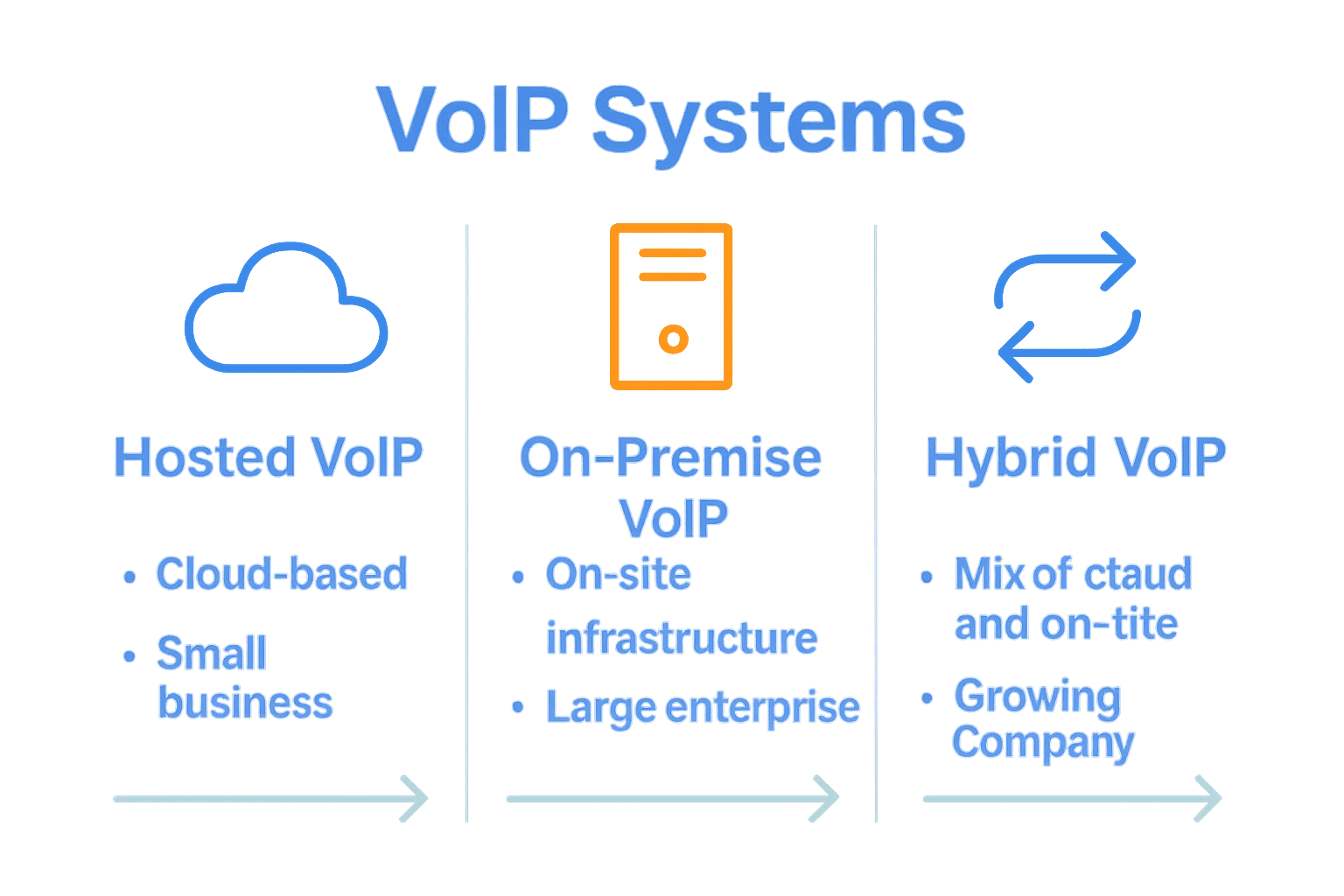Over half of professionals work from home at least part of the week, reshaping how companies connect teams and serve customers. As remote work continues to grow, finding reliable phone solutions is more important than ever. Businesses now turn to advanced communication tools that blend flexibility and performance, giving staff the freedom to work from anywhere without missing a beat.
Table of Contents
- Defining Remote Work Phone Solutions
- Types Of Remote Business Phone Systems
- Essential Features For Remote Teams
- Security, Compliance, And Data Privacy
- Cost, Scalability, And Management Challenges
Key Takeaways
| Point | Details |
|---|---|
| Integration of Technology | Remote work phone solutions utilize advanced communication technologies, enhancing flexibility and connectivity for professionals outside traditional office settings. |
| Variety of Systems | Businesses can choose from multiple remote phone system types, such as Hosted, On-Premise, and Hybrid VoIP systems, based on their specific needs. |
| Security Measures | Robust security protocols, including encryption and multi-factor authentication, are essential for protecting sensitive information in remote communication environments. |
| Cost and Scalability | Organizations must anticipate both the initial and ongoing costs of remote communication infrastructures while also ensuring scalability to adapt to dynamic workforce demands. |
Defining Remote Work Phone Solutions
Remote work phone solutions represent a technological framework enabling professionals to communicate seamlessly outside traditional office environments. According to the National Academies Press, telework is defined as work performed outside standard office spaces, utilizing information technology for communication and task completion.
Remote communication technologies have revolutionized how businesses approach workforce connectivity. These solutions go beyond simple telephone systems, integrating advanced features like mobile softphones, cloud-based calling, voice-to-email transcription, and unified communication platforms. National Academies Press emphasizes that information technology plays a crucial role in enabling these flexible work arrangements.
Key characteristics of modern remote work phone solutions include:
- Seamless integration across multiple devices
- Cloud-based infrastructure
- Advanced call routing capabilities
- VOIP (Voice over Internet Protocol) technology
- Mobile and desktop application compatibility
Understanding these solutions requires recognizing their fundamental purpose: maintaining professional communication standards while providing unprecedented workplace flexibility. As National Academies Press notes, these technologies allow professionals to work effectively from virtually any location with internet connectivity, transforming traditional workplace dynamics.
For businesses considering implementing remote work phone solutions, how to support remote workers on your phone system provides comprehensive guidance on navigating this technological transition.
Types of Remote Business Phone Systems
Remote business phone systems have evolved dramatically, offering diverse technological solutions to meet the complex communication needs of modern organizations. National Academies Press highlights the critical importance of understanding various telework communication tools that enable seamless professional interactions.
VoIP (Voice over Internet Protocol) Systems represent the most prevalent type of remote business phone solution. These internet-based communication platforms allow businesses to make voice calls through broadband internet connections instead of traditional telephone lines. Key variants include:
- Hosted VoIP Systems: Managed entirely by service providers
- On-Premise VoIP Systems: Installed and maintained directly by the organization
- Hybrid VoIP Systems: Combining cloud and on-site infrastructure
Cloud-based phone systems have become increasingly sophisticated, offering features that extend far beyond basic calling capabilities. American University notes that modern communication technologies provide integrated solutions that support diverse workforce needs, including mobile softphones, video conferencing, instant messaging, and advanced call routing.
Businesses can select from several remote phone system architectures:
Here’s a summary comparing the main types of remote business phone systems:
| System Type | Key Features | Typical Use Case |
|---|---|---|
| Hosted VoIP | Cloud managed Minimal in-house hardware |
Small to mid-sized businesses |
| On-Premise VoIP | Local management Higher control |
Large enterprises |
| Hybrid VoIP | Combines cloud & on-site Flexible scaling |
Businesses with mixed needs |
| Softphone Applications | Operates on devices Easy deployment |
Mobile or remote teams |
| Unified Comms Systems | Multiple channels Integrated tools |
Organizations needing all-in-one platform |
- Softphone Applications: Software-based phone systems operating on computers and mobile devices
- Mobile VoIP Solutions: Smartphone-integrated communication platforms
- Unified Communication Systems: Comprehensive platforms combining multiple communication channels
For a deeper exploration of business communication technologies, our complete guide to business phone systems offers comprehensive insights into selecting the right solution for your organization’s unique requirements.
Essential Features for Remote Teams
Remote team communication technologies have transformed workplace collaboration, creating sophisticated ecosystems that enable seamless professional interactions. National Academies Press emphasizes the critical importance of real-time access to shared information and synchronous communication tools for distributed workforce environments.
The most crucial features for remote teams include:
- Instant Messaging: Enables quick, real-time communication
- Video Conferencing: Supports face-to-face interactions
- Screen Sharing: Facilitates collaborative work and presentations
- Cloud Document Storage: Allows simultaneous file access and editing
- Call Routing: Ensures seamless communication across different locations
American University highlights that modern remote work tools must prioritize productivity and connectivity. Advanced communication platforms now integrate multiple functionalities, transforming traditional communication barriers into opportunities for enhanced collaboration.
Key technological capabilities that distinguish top-tier remote team solutions include:
- Multi-Device Compatibility: Seamless transitions between smartphones, tablets, and computers
- Advanced Security Protocols: Protecting sensitive business communications
- AI-Powered Call Management: Intelligent routing and transcription services
- Performance Analytics: Tracking team communication effectiveness
For businesses seeking to optimize their remote communication strategies, our guide on VoIP services for remote workers provides comprehensive insights into selecting the most effective technological solutions.
Security, Compliance, and Data Privacy
Data security in remote work environments has become increasingly complex and critical for modern businesses. National Academies Press emphasizes the paramount importance of implementing robust security measures that protect sensitive information across distributed communication networks.
Key security considerations for remote communication systems include:
- Encryption Protocols: Protecting data during transmission
- Multi-Factor Authentication: Preventing unauthorized access
- Network Segmentation: Isolating sensitive communication channels
- Regular Security Audits: Identifying and addressing potential vulnerabilities
- Comprehensive Access Controls: Managing user permissions and data visibility
American University highlights that effective compliance strategies must go beyond basic technological solutions. Modern organizations need comprehensive approaches that integrate technological safeguards with clear operational policies and ongoing employee training.
Advanced security frameworks for remote work encompass multiple layers of protection:
- End-to-End Encryption: Securing communication from origin to destination
- Continuous Monitoring: Real-time threat detection and response
- Compliance Management: Adhering to industry-specific regulatory requirements
- Incident Response Planning: Rapid mitigation of potential security breaches
Businesses seeking to navigate the complex landscape of remote work security can find comprehensive guidance in our guide to navigating HIPAA security rule changes, which offers insights into maintaining robust communication security.
Cost, Scalability, and Management Challenges
Remote work infrastructure represents a significant strategic investment for modern businesses, requiring careful financial and operational planning. National Academies Press emphasizes that organizations must navigate complex cost structures and management challenges inherent in distributed communication systems.
Cost considerations for remote communication technologies include:
- Initial Implementation Expenses: Hardware and software investments
- Ongoing Subscription Costs: Monthly or annual service fees
- Training and Transition Expenses: Employee onboarding and skill development
- Maintenance and Upgrade Investments: Keeping technological infrastructure current
- Support and Technical Management: Dedicated IT resources for remote systems
American University highlights that scalability represents a critical challenge for businesses implementing remote work solutions. Organizations must design communication infrastructures that can dynamically adapt to changing workforce sizes and technological requirements.
Strategic approaches to managing remote work challenges involve:
- Flexible Licensing Models: Enabling quick user addition or reduction
- Cloud-Based Infrastructure: Supporting seamless technological scaling
- Modular Communication Platforms: Allowing incremental system expansions
- Predictive Cost Management: Forecasting and controlling technological investments
Businesses looking to optimize their remote communication strategy can gain deeper insights through our comprehensive guide to business phone systems, which provides strategic perspectives on managing technological investments and scalability challenges.
Empower Your Remote Team with Modern Phone Solutions
The article highlights the challenges of maintaining seamless communication while supporting a remote or hybrid workforce. If you’re frustrated with outdated phone systems that limit flexibility, complicate management, or drive up costs, know that you are not alone. Key pain points such as the need for cloud-based infrastructure, multi-device compatibility, and advanced call routing must be addressed to keep your team connected and productive.
At Voipcom, we specialize in delivering flexible and scalable business phone systems designed for remote teams. Our hosted PBX and AI-powered calling features adapt effortlessly to your changing workforce needs, providing you with mobility tools like voicemail-to-email and mobile softphone apps—exactly the kind of technology detailed in the article to boost remote communication. Discover how our fully managed services help eliminate complexity while ensuring security and cost predictability.
Ready to transform your remote work communication?
Explore our comprehensive solutions today at Voipcom and gain valuable insights from our guide on VoIP services for remote workers. Then step up your communication game with expert tips on how to support remote workers on your phone system. Take action now to empower your team with technology built for modern work dynamics.
Frequently Asked Questions
What are remote work phone solutions?
Remote work phone solutions are technological frameworks that enable professionals to communicate seamlessly outside traditional office environments using internet-based communication technologies.
What types of remote business phone systems are available?
Common types of remote business phone systems include VoIP systems (hosted, on-premise, and hybrid), softphone applications, and unified communication systems which integrate multiple communication channels.
What essential features should remote teams look for in communication technologies?
Key features include instant messaging, video conferencing, screen sharing, cloud document storage, and advanced call routing to facilitate effective collaboration and connectivity.
How can businesses ensure security and compliance in remote communication systems?
Businesses can ensure security by implementing encryption protocols, multi-factor authentication, regular security audits, and comprehensive access controls while adhering to industry regulations and conducting ongoing employee training.
Recommended
- Unleashing the Power of VoIP Services: How Remote Workers Can Benefit – Voipcom
- How to Support Remote Workers on Your Phone System – Voipcom
- 7 Types de connectivité internationale à maîtriser Nov-2025 | SimCornerAustralia 7 Types de connectivité internationale à maîtriser Nov-2025 | SimCornerAustralia





